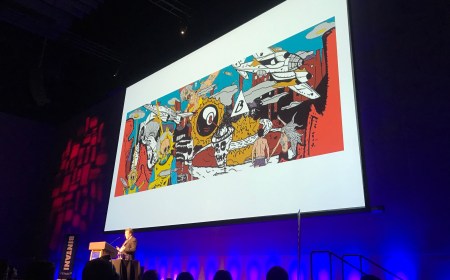
Beavertown as a brand the “redefined” the market
British beer writer Pete Brown called on Australian independent brewers to embrace marketing and take on the big brands in his keynote speech at BrewCon.
The chairman of the British Guild of Beer Writers began his talk by his time working in the beer marketing and advertising world, taking the conference through some of the funniest British beer ads of the 80s and 90s. He then explored where those brands went wrong in their marketing – losing sight of the consumer or “marketing myopia”.
He highlighted what customers are looking for in beer now, “the quest for authenticity”. However, while people want authenticity, they have a harder time pinning down what it is.
“If you think it’s fun trying to define ‘craft’, try to define ‘authenticity’,” he said.
Other trends that have been going on for decades include the growth of the experience economy and the need for “touchy-feely” products and experiences, the chance to interact with real things in an age where we’re spending more and more time online.
“I’ve mapped these trends,” said Brown. “Every one of those trends drives craft beer and craft beer drives most of the trends. It’s a big cultural moment.”
However, Brown noted that while the word ‘craft’ has tapped into trends, the word ‘independent’ – a core tenet of the Independent Brewers Association (IBA) – didn’t, presenting the industry with the challenge to “make the word ‘independent’ stand for something meaningful”.
Early adopters and the majority

Brown cited a popular marketing idea – that of innovators and early adopters buying into a product and then eventually the mainstream consumer catching up. Craft beer has captured the innovators and early adopters and these people care about the independence of beers, but mainstream consumers are still happy drinking beer owned by bigger breweries. How can craft brewers change their minds?
“If you go to them and say ‘you should drink this beer, it’s independent’, they’re going to say ‘well, I’m already drinking this beer that’s not. What’s the benefit to me?'”
Difference between selling and marketing
As someone who previously worked in beer marketing, Brown understands what marketing is and, more importantly, what it isn’t.
“Selling is where you make a product and find someone to buy it,” he said. “Marketing starts with the consumer. Here’s a bunch of people, here’s something they need that’s not currently being supplied to them.
“People don’t want to buy an electric drill, unless you’re drill geek in that early majority. What people really want is a quarter inch hole. If you can come up with a better way of making quarter inch holes there’s no market for drill bits any more.”
However, finding out what people need isn’t as simple as asking them, as there are things that the consumer doesn’t even know they need.
“A lot of people in the early 1980s America probably did sit in focus groups and say ‘I find the taste of mainstream lager dull and uninspiring’, but there wasn’t one of them that said ‘if only there was a rough take of a British premium ale style that’s been adopted for a non cask ale market and aggressively hopped, that has citrusy, piney and fruity aromas rather than the spicy herby aromas of a British ale’. But craft beer came along and met this unarticulated consumer need.”
Craft beer became successful by accident and “without the permission of some of the biggest corporations in the world”, but the craft beer industry can no longer rely on happy accidents. It has to accept and embrace the importance of marketing and do it better than the big boys.
“Now marketing beer is built on a combination of social media and local events. Craft brewers understood this implicitly. Craft beer remembered and reinvented beer sociability through a combination of events.”
Brands
A beer has a brand whether it likes it or not, because a brand is “a collection of meanings commonly held by people”. As such, breweries should exert control over it otherwise they run the risk of losing control like Stella Artois did in the 90s, when it became known as “wife beater” by consumers and even supermarkets.
Brown cited Beavertown as a brand that broke “every single rule of good branding” and thus “redefined the market”.
Through “design and events and social media”, craft brewers can make their brands stand out in more “nimble and flexible” ways than the big brewers, but the big brewers are catching up. “If they weren’t coming after craft, they wouldn’t be doing their job.”
So Brown called on craft brewers to find new ways to use what they have and big brewers don’t to better market their beers.
“Don’t ape what these big guys do badly, don’t try to copy it because they’ve got much bigger budgets than you. Do what they can’t do and do it well.
“Use your small scale, use your independence, think about what you’ve got that they don’t. Think about the drill bit and the hole. What are people buying when they buy your beer? You’re selling them a confection of hops, barley, yeast and water, but that’s not what they’re buying. They’re buying flavour, refreshment, communion, that beer moment. In a pub they’re drinking beer as a means to an end, to capture the moment.
“And that’s why independent beer has an advantage. Because you’re smaller scale, you’re more intimate you’re more personal. You should be reminding people that a pound spent at a local brewery, 70% of that pound stays in the local community.
“Remember, beer is inclusive, it’s about communion. Remember it’s fun and irreverent. Don’t take it too seriously.
“You’re better at it than the big guys and that’s why you’ve succeeded selling independent beer to a mainstream audience. Just don’t be afraid to call it marketing.”
